From Mercury to Nova: Launching the Future at Space Launch Complex 14For over 50 years, Space Launch Complex 14 sat quiet and dark. Today, the lights are back on. In just under one year, this historic Cape Canaveral site has gone from a museum landmark on the KSC bus tour to a reawakening launch facility – rebuilt with modern systems to support Nova, our fully reusable, medium-lift rocket. Here's a look at how we ended up at this storied site, what we've built thus far, and how we're staying on track to bring it back online and operational by early 2026.

Above: First Light – at SLC-14 and in the Florida morning sky. (Stoke Space)
A Historic Launch Site with a New Mission
Space Launch Complex 14 (SLC-14) is one of the most iconic launch pads in space history. It's best known as the site of John Glenn's 1962 mission aboard the Friendship 7 spacecraft, launched on a Mercury-Atlas rocket, which made him the first American to orbit Earth. The pad went on to support 35 launches, including four of the seven crewed Project Mercury missions, laying the groundwork for the Gemini and Apollo programs that followed. SLC-14 was retired in 1967 and later designated a National Historic Landmark, standing for decades as a monument to the earliest chapter of American human spaceflight.
When we started thinking about where Stoke would launch from, we didn't exactly expect to end up here. At the time, most launch startups were planning to use temporary facilities or shared pads with mobile infrastructure. But with a fully reusable rocket designed to fly at a high cadence, we knew we needed a more permanent solution that was traceable to our long-term vision. A site purpose-built to support rapid reuse was essential, because anything else would be a diversion of time and money.
Cape Canaveral Space Force Station (CCSFS) quickly rose to the top of the list. As our CEO Andy Lapsa put it, "Cape Canaveral is the New York City of space launch; it's where everyone wants to be. The major launch companies are there, the customers are there, the talent is local, and it has a tried-and-true playbook for executing launches at an ever-increasing cadence."
So in 2021, with a tiny team and a big vision, we worked with key decision-makers at CCSFS to begin understanding what it would take to secure a launch site. When SLC-14 came up as a possibility, we jumped on it. We committed early resources to show the Space Force we were serious, and we got to work clearing the hurdles required to earn our spot. About a year later, it was official: SLC-14 would be Stoke's home for launch.
Breaking Ground
When we first arrived at SLC-14, the existing infrastructure was in rough shape. The original steel structures had already been dismantled for safety reasons back in the 1970's, and the concrete structures that remained were crumbling in disrepair. But before we could begin any construction, we had to navigate a rigorous approval path.
On October 20, 2024, after a nearly two-year process, we completed the Environmental Assessment and officially secured the license to develop and operate SLC-14. Less than 24 hours later, heavy machinery was in motion and ground was broken, setting the pace for a build at breakneck speed.
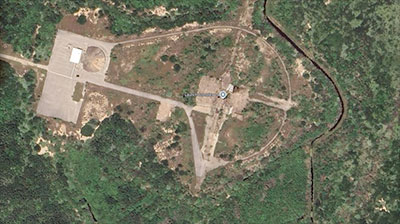
Above: Space Launch Complex 14: Initial State (Stoke Space)
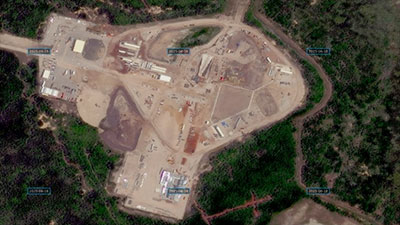
Above: Space Launch Complex 14: June 18, 2025 (Stoke Space)
Today, earthwork across the site is largely complete. Nearly 4,000 dump trucks of fill soil have reshaped the land into its new, final elevations, ready to support the roads, structures, and equipment to come. Just below the surface, a new 9.5-mile network of underground utilities – power, data, water, and more – has been installed, forming the backbone of a modern 21st century launch site.
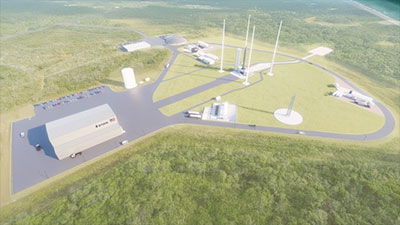
Above: The Stoke Space Launch Complex 14 Layout (Stoke Space)
Building for Rapid Reuse and Repeatability
Since Nova is designed to be fully reusable, we're building infrastructure not just for liftoff, but for rapid turnaround and frequent flights. To move as fast as possible, the systems that make launch possible were being fabricated off-site before being installed in their final position, even as earthwork continued in other areas of the site.
Horizontal Integration Facility (HIF)
Once ready for launch, Nova's major elements – the first stage, second stage, and payload fairing – are transported cross-country to Florida from our factory just outside of Seattle, Washington. Once they arrive at SLC-14, they're brought into the HIF for final assembly and system checkouts. Here, the rocket is positioned horizontally during processing, making it easier and more efficient to access key systems before being rolled out to the pad and raised vertical for launch.
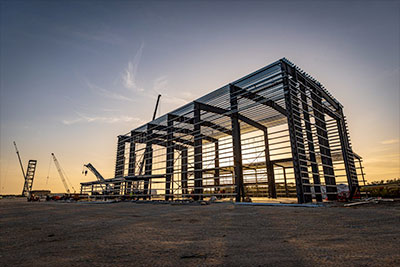
Above: The Horizontal Integration Facility super-structure (Stoke Space)
The facility is designed to handle multiple vehicles at once, whether they're new builds or recovered boosters. Over time, we plan to expand it further to include customer payload processing to further streamline operations. Today the foundation of the building is complete, the steel structure is in place, and the building will be fully enclosed by the end of September.
Launch Mount
About 700 feet from the HIF, the launch pad itself is under construction. Its foundation is anchored by thick 105-foot-deep concrete pilings, and the reinforced concrete launch mount – massive structure that will secure Nova in place until liftoff – has been installed.
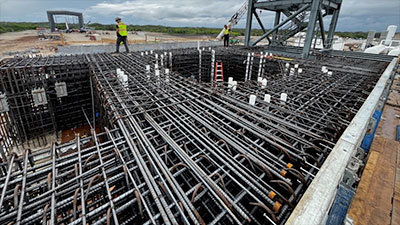
Above: Rebar being placed in the launch mount structure prior to concrete placement. The structure is designed to react up to 1.2 million pounds of thrust from the launch vehicle. (Stoke Space)
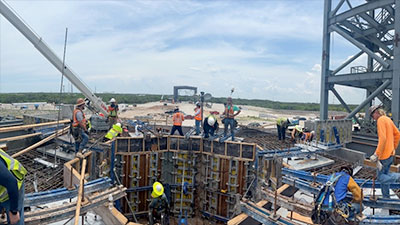
Above: The crew preparing the launch mount for concrete placement. The HIF can be seen in the background. (Stoke Space)
Umbilical Support Structure
Next to the launch mount stands the completed 121-ft tall umbilical support structure. Once fully integrated, this tower will deliver power, propellants, and data to the rocket while it's on the pad, right until the rocket releases its mechanical connection with the ground at liftoff.
Flame Trench and Diverter
Just below the launch mount lies the flame trench, which extends 30 feet into the ground. Its thick, steel-reinforced concrete walls are built to contain and direct the rocket's exhaust, protecting the pad structure from extreme heat and pressure. Inside the trench, a water-cooled stainless-steel flame diverter is under construction. Similar to the one at our Moses Lake Test Facility, its curved, heat-resistant surface is designed to physically deflect the rocket plume from vertical to horizontal and away from the rocket. This ensures minimal to no maintenance of the pad after liftoff, allowing for rapid turnaround between launches.
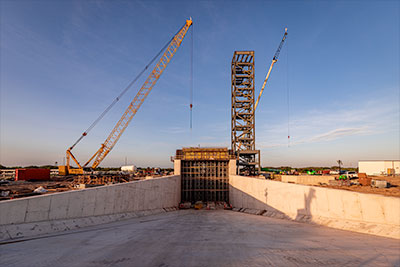
Above: The Launch Mount and the competed Umbilical Tower and Flame Trench. (Stoke Space)
Propellant Systems
Reinforced concrete foundations for the fuel, oxidizer, inert, and water farms are in place, and the new storage tanks have been installed on their permanent mounts. The propellant farms are arranged 120 degrees apart around the pad, and use pressure builders instead of mechanical pumps to pressurize the propellant lines to the rocket. This design simplifies the system, making it easier to operate repeatably and reliably.
Execution, Execution, Execution.
The launch complex is coming together at a record pace and is on schedule to be operational in time to support Nova's first launch. "What's really motivating for me working on this pad for Stoke is the insane and inspiring schedule," says Jonathan Lund, Stoke VP of Launch & Recovery. "We are making an operational launch site in one year. I think it's the fastest pad build — from concept to operation — that anyone's seen for this size of launch vehicle. All with the best set of individuals I have ever worked with. It's just the best and the brightest doing incredible things."
In the coming months, we will continue to make rapid, daily progress that becomes more visible over time, from the rising of the four lightning protection towers on the pad, to the enclosing of the HIF's steel frame, and the painting of the hangar walls with the giant flame of the Stoke logo.
Preserving a Legacy
"It's humbling to be a part of a launch complex with such a rich history. And I think the best way to honor it is to use it." – Jonathan Lund, Stoke VP Launch and Recovery
SLC-14 holds a unique place in spaceflight history, and being here means honoring that legacy and foundation, while also building for the future. In some cases, quite literally: more than 8,000 tons of concrete from the Mercury-Atlas era have been crushed and reused on-site, forming the base of new roads and structural foundations for Nova operations.
The original Blockhouse – the windowless concrete bunker near the pad where launch personnel were stationed during hazardous operations – is still standing. Under a shared-use agreement between Stoke and the Space Force, the Cape Canaveral Space Force Museum will continue to maintain the Blockhouse as both a museum and a venue for educational programs for the public.
At the entrance to the complex stands the Mercury 7 program monument, a tribute to the first astronauts who flew from this pad. Buried beneath it is a time capsule from 1964, filled with keepsakes and a message to the future, sealed until 2464. The monument will continue to welcome CCSFS tourists, our customers, and Stoke team members alike – a reminder of where the foundations of human spaceflight were laid, and just beyond it, a hint at what is to come.
Bringing SLC-14 back to life at this pace has demanded not only relentless execution, but also a deep respect for the scale of the challenge. Soon, we aim to meet that challenge by launching fully reusable rockets from this site – ultimately as frequently and reliably as planes fly in and out of MCO. Until then, the lights are on. The work continues. And weld by weld, the pad awakens.

























